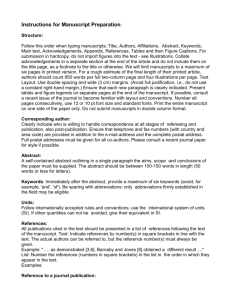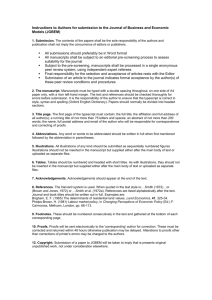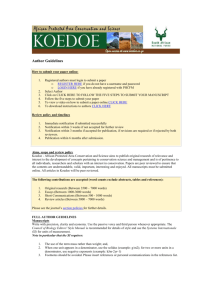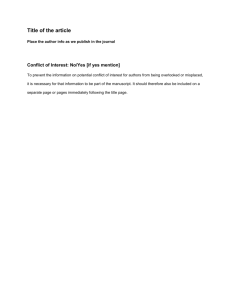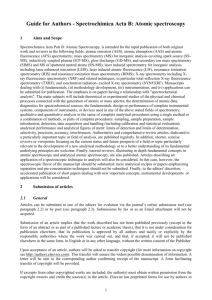Guideline for preparation of manuscript
advertisement
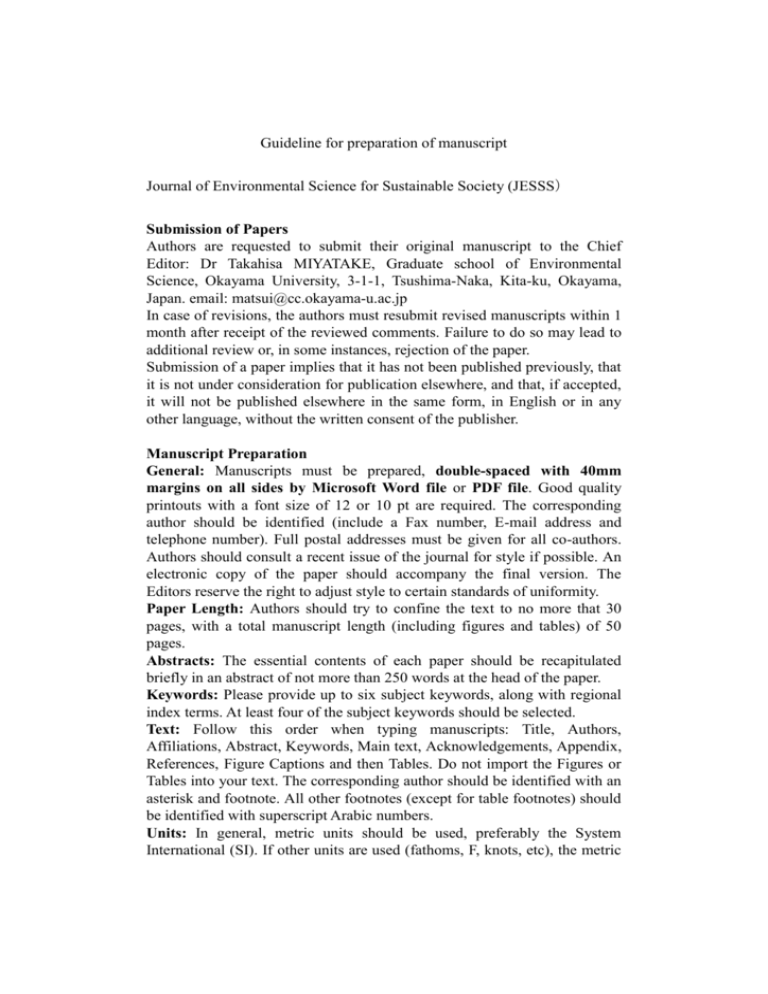
Guideline for preparation of manuscript Journal of Environmental Science for Sustainable Society (JESSS) Submission of Papers Authors are requested to submit their original manuscript to the Chief Editor: Dr Takahisa MIYATAKE, Graduate school of Environmental Science, Okayama University, 3-1-1, Tsushima-Naka, Kita-ku, Okayama, Japan. email: matsui@cc.okayama-u.ac.jp In case of revisions, the authors must resubmit revised manuscripts within 1 month after receipt of the reviewed comments. Failure to do so may lead to additional review or, in some instances, rejection of the paper. Submission of a paper implies that it has not been published previously, that it is not under consideration for publication elsewhere, and that, if accepted, it will not be published elsewhere in the same form, in English or in any other language, without the written consent of the publisher. Manuscript Preparation General: Manuscripts must be prepared, double-spaced with 40mm margins on all sides by Microsoft Word file or PDF file. Good quality printouts with a font size of 12 or 10 pt are required. The corresponding author should be identified (include a Fax number, E-mail address and telephone number). Full postal addresses must be given for all co-authors. Authors should consult a recent issue of the journal for style if possible. An electronic copy of the paper should accompany the final version. The Editors reserve the right to adjust style to certain standards of uniformity. Paper Length: Authors should try to confine the text to no more that 30 pages, with a total manuscript length (including figures and tables) of 50 pages. Abstracts: The essential contents of each paper should be recapitulated briefly in an abstract of not more than 250 words at the head of the paper. Keywords: Please provide up to six subject keywords, along with regional index terms. At least four of the subject keywords should be selected. Text: Follow this order when typing manuscripts: Title, Authors, Affiliations, Abstract, Keywords, Main text, Acknowledgements, Appendix, References, Figure Captions and then Tables. Do not import the Figures or Tables into your text. The corresponding author should be identified with an asterisk and footnote. All other footnotes (except for table footnotes) should be identified with superscript Arabic numbers. Units: In general, metric units should be used, preferably the System International (SI). If other units are used (fathoms, F, knots, etc), the metric equivalents must be given in parentheses ( ) or by presenting the dimensionally correct conversion factors as a footnote. References: All the references must be numbered in the order of appearance in the article and the right parenthesized numbers are used at the text where it is referred like this1). For three or more authors, use the first author followed by "et al." in the main text. The reference list must be summarized at the end of the main text. Use 9pt font for the list. The reference list is followed by the date of acceptance with one line spacing between them as shown in the present sample. The title of the journal should be in italics. References should be given in the following form: 1) Miles, J. W.: On the generation of surface waves by shear flows, The Journal of Fluid Mechanics, Vol. 3, Pt. 2, pp. 185-204, 1957. 2) Miche, M.: Amortissement des houles dans le do-maine de l’eau peu profonde, La Houile Blanche, No. 5, pp. 726-745, 1956. 3) Gresho, P. M., Chan, S. T., Lee, R. L. and Upson, C. D.: A modified finite element method for solving the time-dependent incompressible Navier-Stokes equations, part 1, International Journal for Numerical Methods in Fluids, Vol. 4, pp. 557-598, 1984. 4) Smith, W.: Cellular phone positioning and travel times estimates, Proceedings of 8th ITS World Congress, CD-ROM, 2000. References to unpublished literature should be set out in the format detailed below. The following information needs to be provided: Names and initials of all authors, Title of work. All other relevant information needed to identify item. (e.g., technical report, Ph.D. thesis, institute, current status i.e. in press/unpublished, etc) Iwata, T.: Research on carbon dioxide exchange across air-sea interfaces, Ph.D. Thesis, Okayama University, Okayama, Japan, unpublished. The following provides examples of appropriate citation formats for non-text and electronic-only information. However, it is requested that a Web site address, or listserver message is given as a reference only where the information is unavailable in a more permanent form. If such sources are given, then please give as complete information as possible. Jones, P.: Research activities at Smith Technology Institute. WWW Page, http://www.sti.com/about_us/research, 1996 Green, A.: Deformations in Acanthaster planci from the Coral Sea, observed during UEA Special Project 7, July 1978. Journal of Pollution Research, Vol.14, No.7, suppl. CD-ROM, photographic images, 240 MB, 1991. Illustrations: All illustrations should be provided in camera-ready form, suitable for reproduction (which may include reduction) without retouching. Photographs, charts and diagrams are all to be referred to as "Figure(s)" and should be numbered consecutively in the order to which they are referred. They should accompany the manuscript, but should not be included within the text. All illustrations should be clearly marked on the back with the figure number and the author's name. All figures are to have a caption. Captions should be supplied on a separate sheet. Line drawings: Good quality printouts on white paper produced in black ink are required. All lettering, graph lines and points on graphs should be sufficiently large and bold to permit reproduction when the diagram has been reduced to a size suitable for inclusion in the journal. Dye-line prints or photocopies are not suitable for reproduction. Do not use any type of shading on computer-generated illustrations. Photographs: Original photographs must be supplied as they are to be reproduced (e.g. black and white or color). If necessary, a scale should be marked on the photograph. Please note that photocopies of photographs are not acceptable. Half-tone illustrations should be kept to a minimum. Please note: Because of technical complications which can arise by converting color figures to 'grey scale' (for the printed version should you not opt for color in print) please submit in addition usable black and white prints corresponding to all the color illustrations. Tables: Tables should be numbered consecutively and given a suitable caption and each table typed on a separate sheet. Footnotes to tables should be typed below the table and should be referred to by superscript lowercase letters. No vertical rules should be used. Tables should not duplicate results presented elsewhere in the manuscript (e.g. in graphs). Electronic Submission Authors should submit an electronic copy of their paper with the final version of the manuscript. The electronic copy should match the hardcopy exactly. Authors may submit the text and their papers as Portable Document Format (PDF). Always keep a backup copy of the electronic file for reference and safety.. Proofs Proofs will be sent to the author (first named author if no corresponding author is identified of multi-authored papers) and should be returned within 48 hours of receipt. Corrections should be restricted to typesetting errors; any others may be charged to the author. Any queries should be answered in full. Please note that authors are urged to check their proofs carefully before return, since the inclusion of late corrections cannot be guaranteed. The author should responsible to his corrections. If authors are expecting to be away from their office when the proofs arrive, arrangements should be made with colleagues for the proofs to be checked in the author's absence. © Copyright 2006 Waste Management Research Center |
